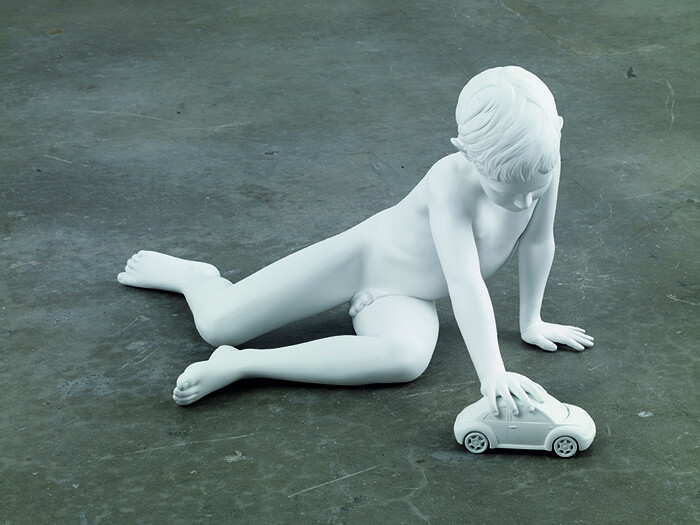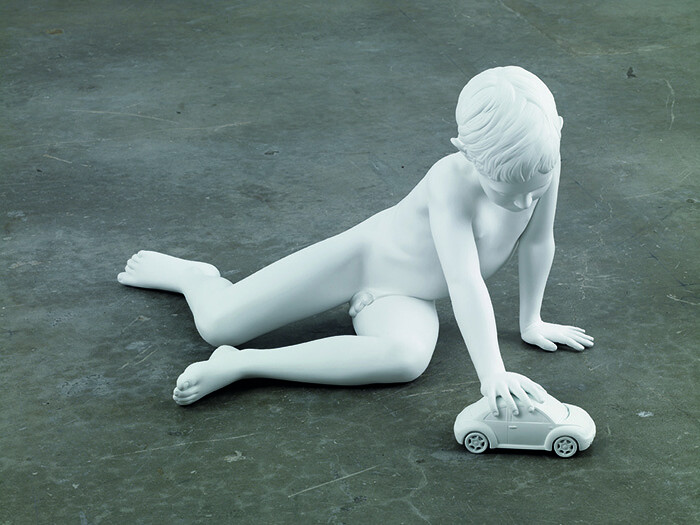Every June, Art Basel lands like a spaceship with a rapacious tractor beam that transfixes the city’s Messeplatz. Within it, for that week, a dense microcosm emerges where the artificial conditions of the elite international art world hold sway. But the effect can be felt further afield too, with some institutions seemingly powerless to resist its gravitational pull. This year the shows around the fair were a mix of resistance, submission, and direct confrontation with the forces that prevail during Art Basel.
At the Kunstmuseum Basel, the solo exhibition “Charles Ray: Sculptures, 1997–2014” (on view until September 28, 2014) is populated by smooth, uncanny human subjects that argue for sculptural figuration in the face of more prevailing inclinations towards abstraction. His figures—perhaps emerging from an unearthly realm beyond—are akin to aliens completely unconcerned with our contemporary ethical or societal foibles. The works include, for example, The New Beetle (2006), a sculpture of a young, naked boy playing with a toy Beetle, who seems completely unaware of the viewers’ uneasy gaze; their admiration of his innocent youth flirts dangerously with pedophilia. On a completely different track, and thoroughly of this world is the exhibition’s car-crash opening gambit, Unpainted Sculpture (1997)—a wrecked Pontiac that Ray remolded piece-by-piece in fiberglass before painting it in pale, matte primer, transforming the violence of a fatal collision into baroque-style curlicues. The resulting form, completed nearly two decades ago, seems to have presaged the more recent trend of pimping urban cars with “stealth” matte paint and wraps.
Although the Fondation Beyeler may be located in the nearby town of Riehen, close to the German border and surrounded by fields, this week it is filled with spillover crowds of zombie-like visitors from Art Basel, who move past the canvases of prolific German painter Gerhard Richter without even looking at them. Focusing on his painting series and cycles, the Beyeler’s exhibition, entitled “Gerhard Richter: Pictures/Series” (on view until September 7, 2014), is the artist’s largest presentation in Switzerland to date, as well as one of his several recent major shows in the country. It was, therefore, a shame that although most of Richter’s cycles were shown in their entirety and even reunited with pieces from different collections, only one work from the “Candle” series (1982–83) appeared. Exhibiting several of them might have amplified the faint resonances of Richter’s inspiration—namely, the (necessarily) silent opposition of citizens of the former German Democratic Republic; however, in isolation, the canvas seemed over-familiar to the point of invisibility.
At equal distance from Basel, but to the southeast of the city, is Muttenz’s Kunsthaus Baselland, where Berlin and New York-based artist Ariel Schlesinger tests the limits of reality in a solo exhibition (open until July 6, 2014), without completely succumbing to the surreal. The largely sculptural installation may seem light, spare, and easy, but it is finely crafted—a fact to which anyone who has seen less successful shows in the Kunsthaus’s challenging gallery spaces would attest. One particular coup is the placement of the artist’s A car full of gas (2008) in a subterranean gallery. Descending the staircase, the viewer spots the nose of a Mini Cooper parked in a space that is indeed better suited for a garage; inching closer, one recognizes two large gas canisters in the front seats, while a disconcerting flame burns merrily as you walk around the car towards the passenger side. Linger to consider the inexplicable mechanism and there’s the added frisson of a faint whiff of gas.
Elements of Naeem Mohaiemen’s exhibition “Prisoners of Shothik Itihash” [Prisoners of Correct History] at the Kunsthalle Basel were already shown at Art Basel last year, specifically the installation Rankin Street, 1953 (2013). But breaking free in the Kunsthalle this summer (running until August 24, 2014), the same work enjoys a rarified context, with the kind of space, time, and focus commercialized platforms can rarely provide. The installation is based on photographs that the artist’s father took of the family in their successive homes in Dhaka, East Pakistan, and Bangladesh. At the fair last year the display seemed nostalgic, but in the Kunsthalle it is situated within a complex arrangement of more than ten extensive works in film, photography, and installation that engage with documentary and fiction. The installation Der Weisse Engel [The White Angel] (2013), for example, includes a short film which intercuts the artist’s text with excerpts from the 1976 film Marathon Man, pitting its cathartic narrative of revenge (exacted against a Nazi war criminal) against the dearth of popular accounts addressing the 1971 war that liberated Bangladesh from Pakistan.
Running virtually in tandem with the behemoth at Messeplatz, the LISTE Art Fair concentrates on a stratum of the art market that can stomach the kind of roughage that settles badly in the main event (except perhaps Art Basel’s Unlimited section that aspires for museum-quality installations). This year, for example, NON from Istanbul displayed several parts of Uriel Orlow’s Unmade Film (2013), which was also shown at the Bergen Assembly last year. As a child, the artist had repeatedly visited his great-aunt in Jerusalem’s Kfar Shaul psychiatric hospital, where she was treated for trauma resulting from her experiences at Auschwitz. Recently, the artist learned that lying beneath the site are the ruins of Deir Yassim, a Palestinian village cleared of its inhabitants in part by a 1948 massacre by Zionist paramilitary groups before Israelis resettled it. Orlow approaches the amnesia formed by the horrors of both holocaust and massacre by assembling the constituent elements of a film as disparate pieces, productively staging the lacunae between them: those shown at LISTE include a script culled from psychiatric reports, and a video sequence depicting actors as they create fragmentary tableaux vivants from living memories or reenact historical events.
At the booth nearby, Proyectos Ultravioleta from Guatemala City—showing at LISTE for the first time—had another meaty display of works by Regina José Galindo, Federico Herrero, Jesus “Bubu” Negron, Naufus Ramírez-Figueroa, and Radamés “Juni” Figueroa. Also proximate is Truth and Consequences, a newcomer from Geneva, which had one of my favorite booths; British/French artist duo Dewar & Gicquel knit two huge, unwearable jumpers approximately two meters tall in Breton-fisherman style, entitled Pull (jersey) and Pull (torsadé) [Sweater (jersey)/Sweater (twisted)] (both 2014), for which the artists grappled not only with the weight of their sculptural ancestry but also, literally, with oversized needles.
Basel is not without off-spaces, and one of its most significant, SALTS in Birsfelden, run by Samuel Leuenberger, has three shows crammed into, and around, his apartment (on view until July 17, 2014). Alongside a four-person painting show organized in collaboration with the Kunsthalle St. Gallen of northeastern Switzerland and “read the room / you’ve got to,” a collection of works on paper by practitioners mingling visual art and the poetic, is Katja Novitskova’s solo exhibition “Green Growth,” which occupies the garage and garden. Novitskova works with stock images, and in this presentation she exhibits pictures of nature alongside graphic images of arrows that ape the upward growth of plants in order to symbolize positive economic growth. On their own, these images depict financial gain as if it were an inevitability, but in the installation at SALTS, they return to nature—prints of the arrows are sealed within clear rubber and hung from trees. If the symbols appropriate and corrupt the nature of nature, Novitskova undermines their meaning—yet it remains to be seen how nature will, in turn, corrupt the materials.
For the Swiss Federal Office for Culture’s annual Swiss Art Awards exhibition— located in Hall 4, one of the outlying spaces of the Art Basel fairgrounds—there seems to be no escape from the fair’s magnetism. It houses a good roundup of up-and-coming national artists, and indeed several who have already made their mark on the international stage. Here one finds the work of Claudia Comte (also shown at Zürich’s BolteLang at LISTE); the duo Taiyo Onorato and Nico Krebs (with Zürich’s RaebervonStenglin at Art Basel Statements); Alexandra Navratil; Guillaume Pilet; and Kaspar Müller—just to name a few. However, all the while I sensed the pressure of the nearby market, and felt anxious, edgy. Perhaps it was because of Florence Jung’s performance piece Jung32 (2014), in which a young woman, pulling a mobile karaoke machine as she sang the Disney theme park ride song “It’s A Small World,” toured the hall in a perpetual loop.
There is nothing like never-ending, high-pitched kitsch offering corporate-sponsored togetherness—in the context of a competition—to make anyone feel ill. After three days, Jung’s performance ended and the artist issued a statement: “the entertainment came to a stop on the third day, when the singers approached a nervous breakdown.” And after all, for the week of Art Basel everyone in the city is under the influence of the fair, and though it brings flashes of brilliance, it’s good, too, when the madness ends.















